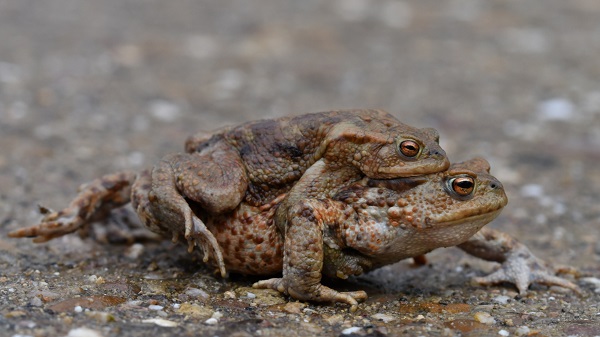 Female toad and her much smaller mate on their risky migration journey;
Credit: © Raymond Gloden
Female toad and her much smaller mate on their risky migration journey;
Credit: © Raymond Gloden
Chronicle.lu has been speaking recently with experts at natur&ëmwelt asbl, a leading nature conservation NGO in Luxembourg, to find out more about current conservation issues; the first such conversation was about toad (and frog) migration.
For this first in a series of articles, natur&ëmwelt volunteer David Crowther helped gather the relevant information from the NGO.
Chronicle.lu: Most people know that birds (and, thanks to wildlife programmes on TV, large herds of African buffalo) migrate. But toads too are migratory?
Natur&ëmwelt: Indeed! Birds (and African buffalo) migrate over long (sometimes very long) distances. Frogs and toads don't cover anything like such distances. But they too put a lot of time and effort into moving temporarily to their ancestral breeding grounds, i.e. ponds.
Chronicle.lu: Why do they do that?
Natur&ëmwelt: Frogs and toads are amphibians: they spend part of the year in the water, part on land. In fact, they spend most of their time on land - in woods and forests, under hedges, and in field margins. But they need ponds to mate and lay their eggs, and their eggs are clumped together in what we know as frogspawn or toadspawn. Tadpoles are the transitional phase between spawn and the finished (but small) article.
Chronicle.lu: What is the difference between frogs and toads?
Natur&ëmwelt: Both are amphibians. Toads are generally bigger, have a dry, warty skin and move by walking. Frogs are smaller, have a damp, smooth skin and hop. Because they move more slowly, toads have a harder time migrating.
Chronicle.lu: Why is that exactly?
Natur&ëmwelt: To get to their breeding ponds, all frogs and toads have to cross roads. Frogs can get across them quicker than toads. But they're all liable to come to a grisly, sticky end unless people (in the form of motorists) take care.
Chronicle.lu: So motorised traffic is the main problem?
Natur&ëmwelt: It is. And there are various ways of helping our frogs and toads deal with this problem. Some new roads are equipped with amphibian tunnels. Road verge fencing prevents amphibians from crossing at any other point. But motorists, for instance, can simply drive more slowly (just doing 30 km/h has a dramatic effect on the fatality rate) wherever there are known migration hotspots. Lots of these (though nothing like enough) are now clearly signposted, so there's no excuse. It's just a matter of taking sensible precautions during the migration season.
Chronicle.lu: Which is when?
Natur&ëmwelt: Any time from mid-February to mid-April. A lot depends on the prevailing weather. Most migration takes place on mild (5-10°C), damp (or wet) nights. That's when motorists should take special care. And that's when volunteer groups will be out and about too.
Chronicle.lu: What do these volunteers do?
Natur&ëmwelt: In many cases, they still collect the animals from endangered stretches of road and take them in buckets to the safe side of the road or straight to their destinations. Increasingly, with many of the main breeding sites known and marked, and with amphibian guide fencing in place to force the creatures to gather in a certain place, it's more a matter of collecting them from those places and giving them a lift. But there's still lots to do and lots of volunteers are still needed!
Chronicle.lu: Are there still places that have not been charted?
Natur&ëmwelt: There are, and new habitats are always being created. Frogs and toads are quite adaptable, so they'll quickly take advantage of a new resource, like a new pond or rainwater retention basin. If you discover a hitherto unknown crossing point, please report it as a matter of urgency so that protective measures can be put in place and the spot marked on the excellent online Géoportail. There’s a form available for this: https://naturemwelt.wufoo.com/forms/z1cgsxsv08qkyc6/. If you're thinking of joining an existing rescue group or setting up a new one, it's the same form.








